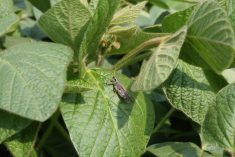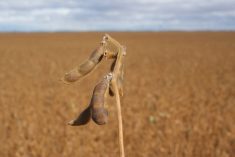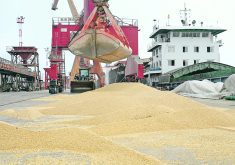Farmers in Manitoba and Saskatchewan grew more than three million acres of soybeans this year. Almost all of those beans are exported to places like China, where they are processed into soybean meal and fed to livestock.
Meanwhile, every year hog farmers in Western Canada import hundreds of thousands of tonnes of soybean meal from the United States to mix into feed rations for their pigs.
Since Western Canada is exporting a product it needs for livestock feed, it seems logical to build a soybean crushing plant on the Prairies and produce soybean meal for the regional market.
Read Also

Farming Smarter receives financial boost from Alberta government for potato research
Farming Smarter near Lethbridge got a boost to its research equipment, thanks to the Alberta government’s increase in funding for research associations.
The logic is straightforward, but a few questions must be answered first, including the most important one: who is going to invest $300 million in the plant?
The Western Opportunities Leadership Group (WOLG), a coalition of community leaders in western Manitoba, is hoping to convince a company to build a soybean processing plant in the region.
For now the WOLG is focused on building a team and getting all players on the same page so that it can make a comprehensive pitch to prospective investors.
“To ensure the best case possible is made to the companies,” Richard Pauls, a consultant working with the group, said at a mid-November WOLG meeting about the soybean plant in Brandon.
Bob Woodward, another consultant for WOLG, presented specs for the potential plant at the Brandon meeting.
• It would process 2,500 tonnes of soybeans per day, which is about 850,000 tonnes of beans a year.
• Construction cost would be around $330 million, including rail access, hydro and water infrastructure.
Manitoba and Saskatchewan farmers produced about 2.7 million tonnes of soybeans this year, based on Soy Canada data, so the proposed plant would need about 30 percent of soybean production.
Soy acres are predicted to expand, particularly in Saskatchewan, but the plant would still require a substantial chunk of all the beans in Western Canada.
“One thing you absolutely have to do, if you’re going to have a successful plant here, is you have to control the bean supply,” said Bob Stroup, a soybean processing plant expert from the United States, who spoke at the Brandon meeting.
“You can’t decide you’re going to build the plant and then (approach farmers).”
Stroup said one solution is forming a co-operative, which acts as the soybean supplier to the plant.
Another concern is that existing oilseed plants in Western Canada can crush soybeans, so a new plant might have to compete for beans.
“You should know that in Yorkton, at least the Louis Dreyfus plant, is what we call a switch plant,” Stroup said.
“It would be pretty easy to switch that into soybeans.”
A participant at the Brandon meeting said the proposed plant in western Manitoba would have to pay a small premium for the beans and possibly pay growers to store the soybeans on the farm.
On top of securing a bean supply, the owners of a prospective plant also need buyers for the soybean meal.
Manitoba pork producers truck in soybean meal from southern Minnesota and South Dakota. They would welcome the shipping savings from a local plant.
“When feed costs are something like half to two-thirds the cost of the pig, any saving on freight … is going to translate to increased (profits),” said Andrew Dickson, Manitoba Pork Council general manager.
Manitoba farmers raised about 4.5 million pigs to market weight last year, not enough to consume all the meal from the proposed plant.
Dickson estimated that Saskatchewan and Alberta farmers produce two million and three million pigs, respectively.
“They buy soy meal as well … now you start to see a marketplace for this (plant).”
However, it’s unlikely that a soybean crusher in western Manitoba would capture 100 percent of the hog market in the region. Plant operators will need to find buyers in North Dakota and Montana or poultry and other livestock buyers in Canada.
Of course, it’s premature to fret about the soybean supply and who will buy the meal because the plant is still hypothetical.
The crucial part of the process is making a business case to a major investor. The WOLG is still getting its ducks in a row, but representatives of the group have approached a few companies, Pauls said.
“We’re talking to them now … in a preliminary way.”
Contact robert.arnason@producer.com


















